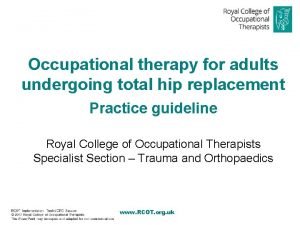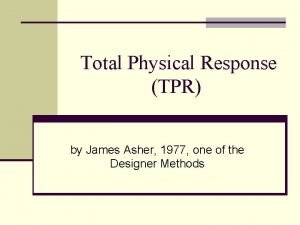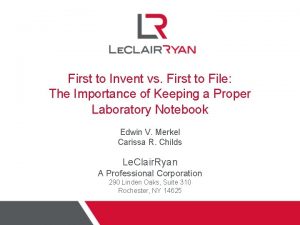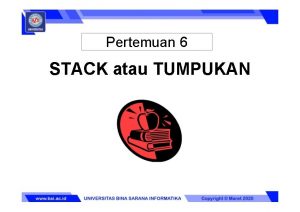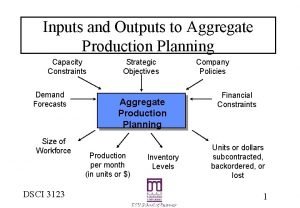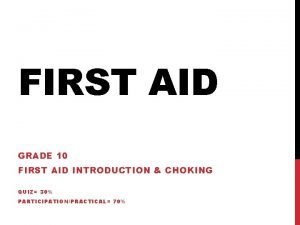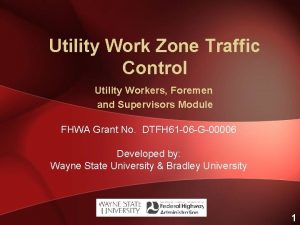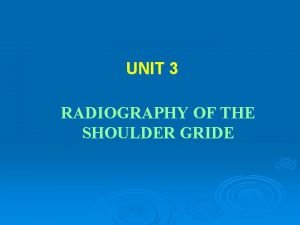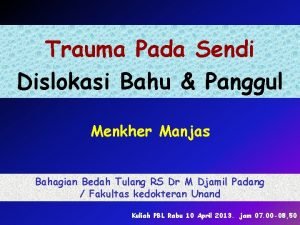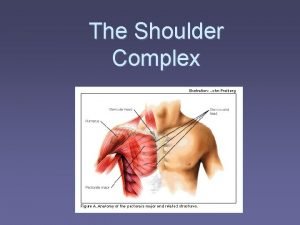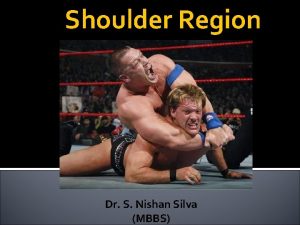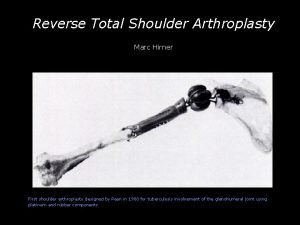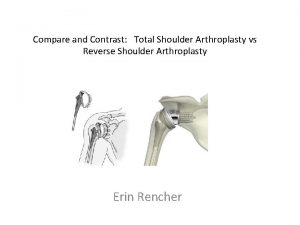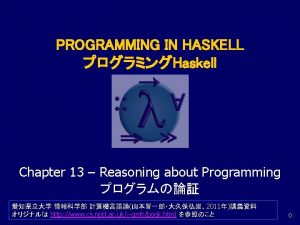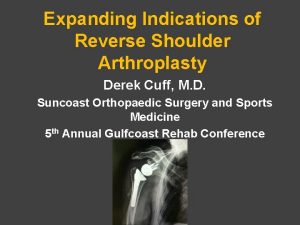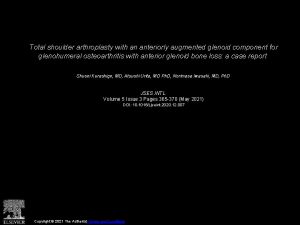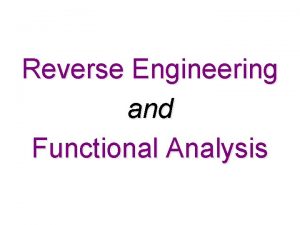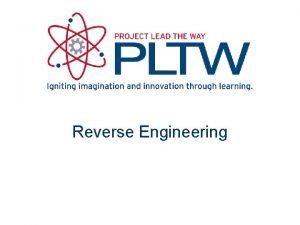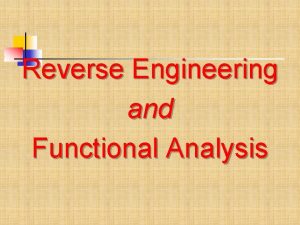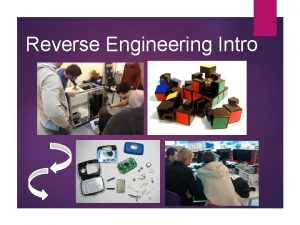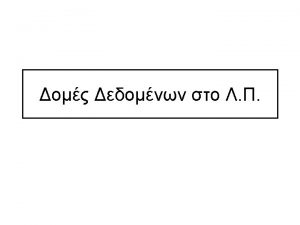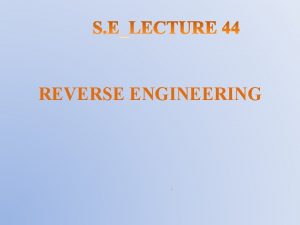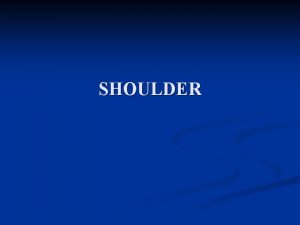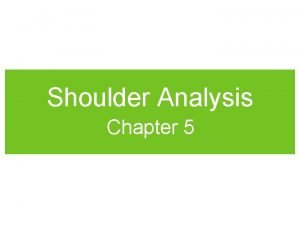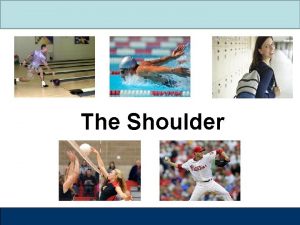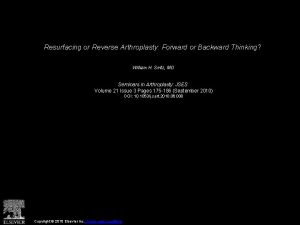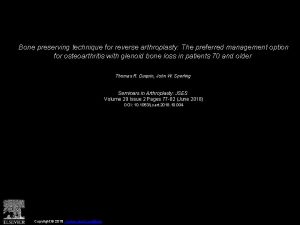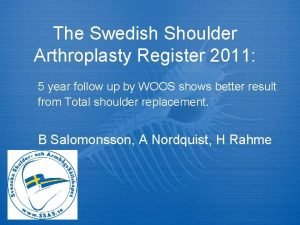Reverse Total Shoulder Arthroplasty First shoulder James H







































- Slides: 39

Reverse Total Shoulder Arthroplasty -- First shoulder James H. arthroplasty Chang May 3, 2007 UCSD First shoulder arthroplasty designed by Pean in 1983 for tuberculosis involvement of the glenohumeral joint using platinum and rubber components

Reverse Total Shoulder Arthroplasty Educational Objectives • Rotator Cuff Arthropathy • Historical review • Clinical presentation • Imaging features • Proposed Etiologies • • -- • Rotator Cuff Theory • Crystalline-Induced Arthritis (Milwaukee Shoulder Syndrome) Treatment Reverse total shoulder arthroplasty • Past Designs • Grammont Delta III Reverse Total Shoulder Arthroplasty • Indications / Contraindications • Biomechanics • Imaging Features

Cuff Tear Arthropathy/Milwaukee Shoulder Syndrome -- • Progressive and destructive arthropathy of the glenohumeral joint in a small percentage of patients with chronic rotator cuff tears

Rotator Cuff Arthropathy – Historical Review -- • Adams and Smith (19 th century) - Earliest description of the pathoanatomical features of rotator cuff tear arthropathy (CTA) Described as localized form of rheumatoid arthritis • Codman (1934) – “subacromial space hygroma” in woman with recurrent shoulder swelling, absence of the rotator cuff, cartilaginous bodies attached to the synovium, and severe destructive glenohumeral osteoarthritis. • De. Seze (1968) - L’épaule sénile hémorragique (the hemorrhagic shoulder of the elderly). Three elderly women w/o trauma history who had recurrent, blood-streaked effusions about the shoulder , severe glenohumeral degeneration, and chronic rotator cuff tears.

Rotator Cuff Arthropathy – Historical Review -- • Mc. Carty and Halverson (1981) - Milwaukee shoulder syndrome. Condition seen in four elderly women who had recurrent bilateral shoulder effusions, severe radiographic destructive changes of the glenohumeral joints, and massive tears of the rotator cuff. • Lequesne et al (1982) - L’arthropathie destructrice rapide de l’épaule (rapid destructive arthritis of the shoulder) - Large spontaneous GHJ effusions and RCT in six elderly women. • Neer et al (1983) - Cuff Tear Arthropathy. Term used to describe GHJ arthritis and massive chronic RCT in 26 patients who had total shoulder replacements • Dieppe (1984) - Apatite-associated destructive arthritis and idiopathic destructive arthritis were introduced to describe rotator cuff tear arthropathy.

Cuff Tear Arthropathy – Clinical Presentation -- • More common in women than men, especially elderly women with long standing shoulder symptoms • Dominant side more commonly affected, bilateral in 60% in one series • Symptoms: • Moderate joint pain • Limited range of motion • Recurrent swelling of the shoulder Physical Exam: • • Swelling about the glenohumeral joint • Atrophy of the supraspinatus and infraspinatus muscles

Cuff Tear Arthropathy – Imaging Features -- • Superior migration of the humeral head with articulation with the acromion sometimes resulting in rounding-off the greater tuberosity. • Severe destructive GJH osteoarthritis • Anterior or posterior humeral head subluxation • Neer et al reported an area of subchondral collapse in humeral head in all twenty-six patients in one series; they considered this finding a requirement for the diagnosis of rotator cuff tear arthropathy

Cuff Tear Arthropathy – Imaging Features -- • Massive tears of the supraspinatus and infraspinatus tendons with muscle atrophy • Glenohumeral joint destruction • Occasionally, geyser phenomenon with fluid communicating between the glenohumeral joint, SA/SD bursae and AC joint as a result of massive rotator cuff tear and ACJ capsular ligament injury

Rotator Cuff Tear Theory Neer et al (1983) – A small percentage (4%) of untreated chronic, massive -rotator cuff tears would lead to severe glenohumeral degeneration from mechanical and nutritional alterations • Mechanical factors: Instability of the humeral head resulting from massive RCT and rupture or dislocation of the long head of the biceps, leading to proximal migration of the humeral head and acromial impingement. • Glenohumeral cartilage loss was a result of repetitive trauma from the altered biomechanics because loss primary and secondary stabilizers of the glenohumeral joint.

Rotator Cuff Tear Theory – Nutritional Factors -- • Nutritional: Inadequate diffusion of nutrients to the cartilage as the loss of a watertight joint space diminished the quantity of synovial fluid. • Disuse osteoporosis of the proximal part of the humerus would decrease the density of the subchondral bone in the humeral head and contribute to atrophy of the articular cartilage. • Degenerative arthritis and subchondral collapse eventually would develop as a result of changes in the articular cartilage.

Milwaukee Shoulder Syndrome – Crystalline-Induced Arthritis of the GHJ -- • Mc. Carty and Halverson (1981) postulated that phagocytized basic calciumphosphate (BCP) crystals in synovial fluid induce release of proteolytic enzymes which cause destruction articular and periarticular tissues. • Hydroxyapatite-mineral phase develops in the altered capsule, synovial tissue, or degenerative articular cartilage and releases basic calcium-phosphate crystals (crystal very similar to Hydroxyapatite) into the synovial fluid. • These crystals then are phagocytized by synovial cells, forming calcium-phosphate crystal microspheroids which induce the release of activated enzymes

Cuff Tear Arthropathy - Treatment • -Medical management of the pain / physical therapy • Arthroscopic lavage / arthroscopic débridement - Limited short-term results; rationale is remove activated enzymes and crystals • Hemiarthroplasty – Provides some return of function but pain relief is variable • Arthrodesis - Not well tolerated because of cosmetic appearance/poor function • Constrained arthroplasty – High rate of glenoid component loosening • Total shoulder arthroplasty - Associated with high rate of glenoid loosening because superior migration of humeral head results in “rocking-horse” phenomenon

Conventional Total Shoulder Arthroplasty: Abandoned because of glenoid component loosening Conventional TSA not satisfactory Because of superior humeral head migration, eccentric loading on the glenoid component resulted in “rocking-horse” glenoid loosening

Hemiarthroplasty: Some pain relief but no significant improvement in range of motion Unconstrained TSA abandoned b/c of glenoid loosening • Relatively fewer problems with glenoid component loosening as in the conventional TSA • Limited pain relief, less than with conventional TSA • Modest improvement in active elevation or abduction can deteriorate as a result of subsequent glenoid and/or acromial erosion

Past constrained reverse shoulder arthroplasty Past constrained reverse ball-and-socket designs: Provided fixed center of rotation but high rate of glenoid loosening • Fixed center of rotation provided some active elevation • Lateral offset of the center or rotation placed increased torque at the glenoid-bone interface resulting in loosening

Grammont reverse TSA Grammont Reverse Shoulder Arthroplasty • Designed in 1985 by Paul Grammont • Used in Europe for past 20 years, approved by FDA in March, 2004 in U. S. • Components: Humeral component, polyethylene insert, glenosphere, metaglene (baseplate)

Grammont reverse TSA Grammont Reverse Shoulder Arthroplasty - Biomechanics Small lateral offset (absence of component neck) places the center of rotation more medially surface and reduces the torque at glenoid-bone interface

Grammont reverse TSA Grammont Reverse Shoulder Arthroplasty - Biomechanics • The lever arm distance (L) is increased and deltoid force (F) is increased by lowering and medializing the center of rotation which is now also fixed • Torque (F x L) in abducting the arm is increased.

Grammont reverse TSA Grammont Reverse Shoulder Arthroplasty - Biomechanics • Large glenoid ball component offers a greater arc of motion

Reverse TSA recruits more deltoid fibers Grammont Reverse Shoulder Arthroplasty - Biomechanics Medializing the center of rotation recruits more of the deltoid fibers for elevation or abduction but… Ant. Pos.

But external rotation is decreased Grammont Reverse Shoulder Arthroplasty … Fewer posterior deltoid fibers are available for external rotation Important to comment on status of teres minor on any MR imaging Ant. findings of Pos. showing rotator cuff arthropathy

Indications for Reverse TSA Indications • Rotator cuff tear arthropathy – most common • Failed hemiarthroplasty with irreparable rotator cuff tears • Pseudoparalysis (i. e. , inability to lift the arm above the horizontal) because of massive, irreparable rotator cuff tears • Some reconstructions after tumor resection • Some fractures of the shoulder (Neer three-part or four-part fx) • Severe proximal humerus fractures with tuberosity malposition or non-union

60 y/o Female With Rheumatoid Arthritis and Pain Courtesy Tudor Hughes, M. D.

Metastatic Renal Cell Cancer to Right Humerus Metastatic renal cell Courtesy Heinz Hoenecke, M. D.

Normal Appearance of Reverse TSA Unconstrained TSA abandoned b/c of glenoid loosening • • • Glenosphere and humeral component should be aligned on trans-scapular Y view Slight posterior position of the humeral component acceptable on the axillary view Metaglene flush against the glenoid

Contraindications for Reverse TSA Contraindications • Primary osteoarthritis or osteonecrosis where the articular surface– tuberosity relationships are normal and the rotator cuff is intact • Marked deltoid deficiency, as the shoulder will not function well and will be prone to dislocate • History of previous infection – recurrent infection high • Use sparingly in patients less than 65 years old, as long-term survivorship and complication rates are unknown

Complication rates Complication Rates for Reverse TSA • Higher for intraoperative and postoperative complication rates for reverse TSA (mean 24%) vs. conventional TSA (mean 15%) • Besides cuff arthropathy, reverse TSA still regarded a salvage procedure for failed hemiarthroplasties. If exclude these salvage procedure, complication rate is less

Complications of Reverse TSA • Recent postoperative • Hematoma • Dislocation • Prosthesis loosening • Infection • Periprosthetic fracture • Metaglene migration • Late postoperative period: • Scapular erosion • Osteophyte formation • Heterotopic ossification • Acromion or scapular stress fractures

Complication - Dislocation Unconstrained TSA abandoned b/c of glenoid loosening • • • Most commonly anterior-superior b/c unopposed pulled of deltoid muscle 20% of reverse TSA had dislocations in one series More likely to occur if deltoid tension not adequate

Complication – Malposition of the Metaglene (baseplate) Glenoid baseplate not fully seated • • Back of metaglene must be flush to the glenoid Perioperative complication

Complication – Component Loosening Component loosening • The baseplate and glenosphere have migrated superiorly • Irregularity of the glenoid from contact by the humeral component • Humeral component loosening Courtesy Heinz Hoenecke, M. D.

Complication – Scapular Notching • • Most common complication – result of contact of humeral component with inferior margin of the scapula Seen soon after implantation and stabilizes after 1 year. Controversial as to clinical significance but higher grade notching has been associated with lower Constant (postop. patient satisfaction) scores Nerot Classification of Scapular notching Grade 1: Confined to the scapular pillar Grade 2: Notch outline contacts lower Grade 3: Notch over the lower screw Grade 4: Notch extends to baseplate.

Complication – Scapular Notching

Complication – Inferior metaglene screw in soft tissue Malpositioning of metaglene screw

Complication – Acromial Stress Fracture • Unique to reverse TSA • Believed to be secondary to loading to the posterior aspect of the acromion, from increased deltoid tension • Increased load on the acromion may also explain rare complication of scapular spine fracture

Complication – Scapular Spine Fracture in 80 y/o Female Scapular spine fracture Courtesy Heinz Hoenecke, M. D.

Checklist Reverse TSA Radiographic Evaluation Checklist

References 1. Resnick, Donald. Diagnosis of Bone and Joint Disorders – 4 th ed. 2002 2. Boileau P, Watkinson DJ, Hatzidakis AM, Balg F. Grammont reverse prosthesis: design, rationale, and biomechanics. J Shoulder Elbow Surg 2005; 3. Sirveaux F, Favard L, Oudet D, Huquet D, Walch G, Mole D. Grammont inverted total shoulder arthroplasty in the treatment of glenohumeral osteoarthritis with massive rupture of the cuff: results of a multicentre study of 80 shoulders. J Bone Joint Surg Br 2004 4. Mc. Farland E et al. The Reverse shoulder prosthesis: a review of imaging features and complications. Skelel Radiol (2006) 35: 488 -496. 5. Roberts C et al. Radiologic Assessment of Reverse Shoulder Arthroplasty. Radiographics 2007; 27: 223 -235. 6. Jensen K et al. Current Concepts Review Rotator Cuff Arthropathy. JBJS. Vol. 81 A, No. 9. September 199

END
 Arthroplasty practitioner
Arthroplasty practitioner Occupational therapy hip replacement interventions
Occupational therapy hip replacement interventions Disorganized crime scene
Disorganized crime scene Clay lawson and russell odom
Clay lawson and russell odom Tpr theory of language
Tpr theory of language Uafir fórmula
Uafir fórmula Total revenues minus total costs equals
Total revenues minus total costs equals Total revenues minus total costs equals
Total revenues minus total costs equals Total revenues minus total costs equals
Total revenues minus total costs equals Total revenue minus total expenses
Total revenue minus total expenses The first snowfall poem
The first snowfall poem Maturity continuum victories
Maturity continuum victories State space graph
State space graph Sdl first vs code first
Sdl first vs code first Habit 3 lesson plans
Habit 3 lesson plans Habit 3 put first things first
Habit 3 put first things first Difference between code first and database first approach
Difference between code first and database first approach First to file vs first to invent
First to file vs first to invent Stack declaration
Stack declaration Contoh soal stack dan jawabannya
Contoh soal stack dan jawabannya First in first out
First in first out First come first serve
First come first serve Put first things first definition
Put first things first definition Gantt chart first come first serve
Gantt chart first come first serve See do get model
See do get model Habit number 3
Habit number 3 Put first things first video
Put first things first video Put first things first activities
Put first things first activities First aid merit badge first aid kit
First aid merit badge first aid kit What are the objectives of first aid?
What are the objectives of first aid? Put first things first
Put first things first Utility work zone traffic control
Utility work zone traffic control Gride msp
Gride msp News headline example
News headline example Glenohumeralis
Glenohumeralis Parts of the shoulder
Parts of the shoulder Subscapularis muscle action
Subscapularis muscle action Suspension therapy for shoulder joint
Suspension therapy for shoulder joint Flattened deltoid
Flattened deltoid Lat dorsi action
Lat dorsi action

